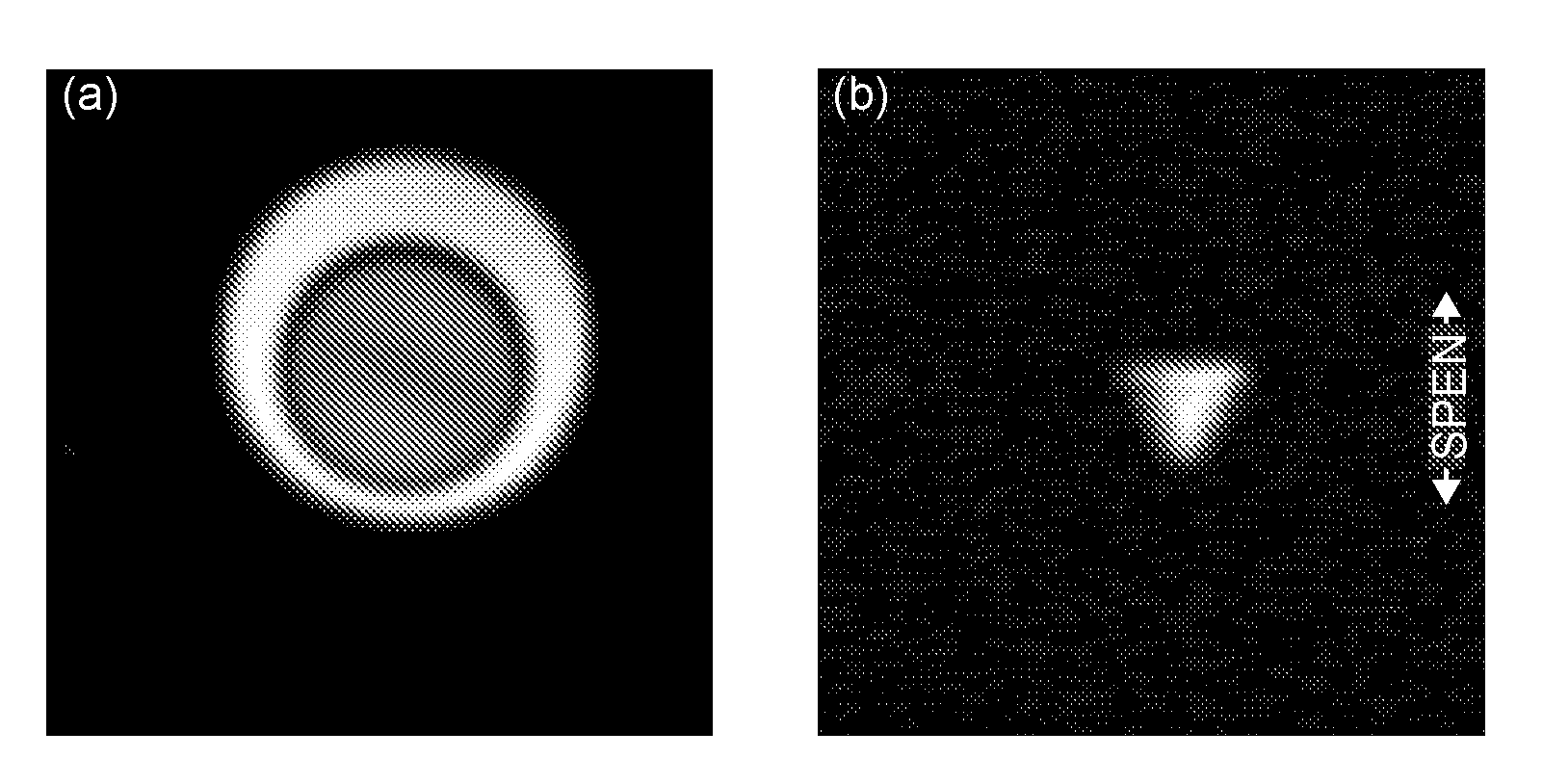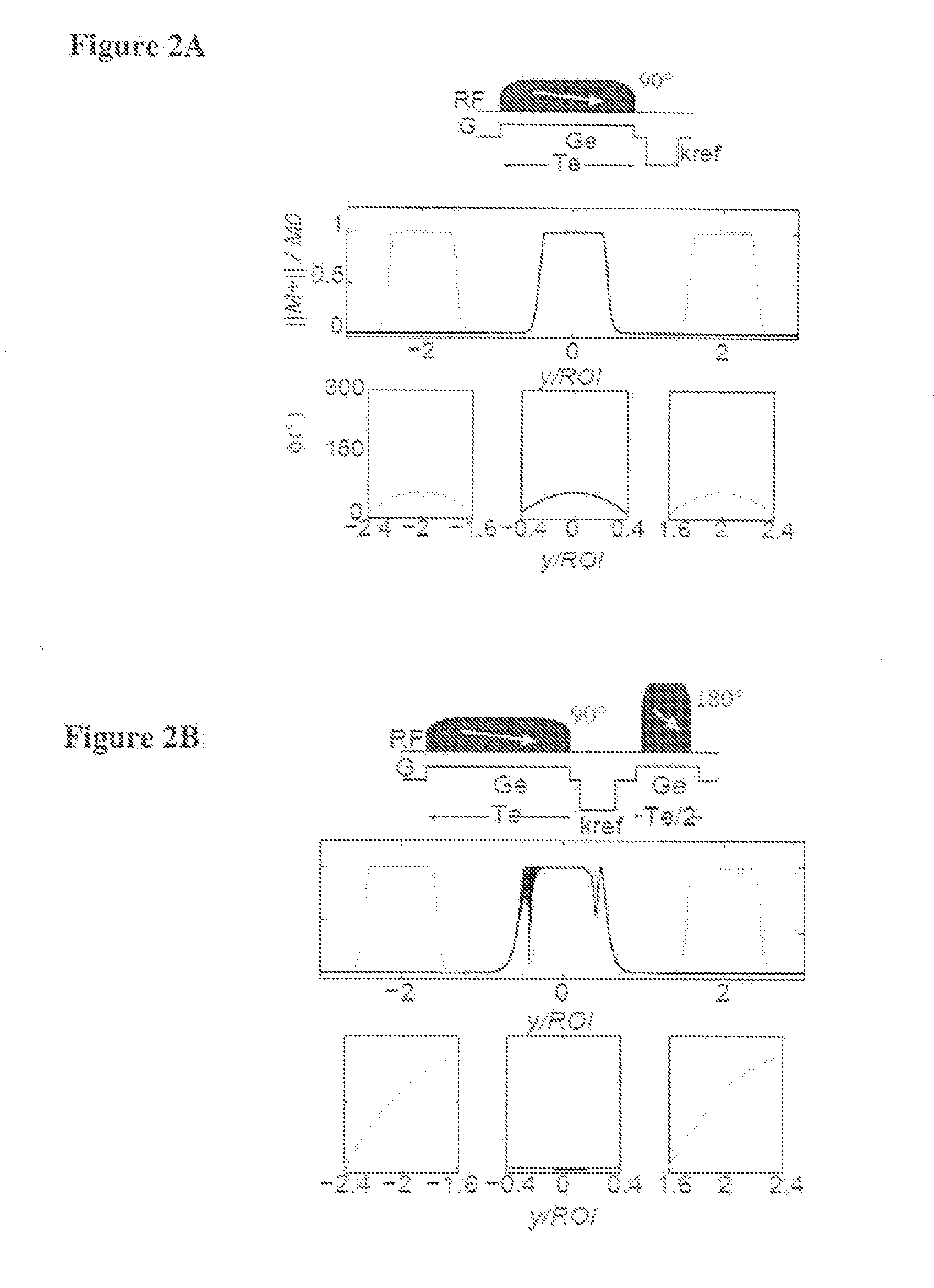Methods for spatial and spectral selectivity in magnetic resonance imaging and spectroscopy
a magnetic resonance imaging and spectroscopy technology, applied in the field of methods for spatial and spectral selectivity in magnetic resonance imaging and spectroscopy, can solve the problems of more complex 2d or 3d regions of interest (rois) and other problems
- Summary
- Abstract
- Description
- Claims
- Application Information
AI Technical Summary
Benefits of technology
Problems solved by technology
Method used
Image
Examples
example 1
Hybrid 2D Excitations and Single-Scan 2D SPEN Imaging
[0153]FIG. 8A shows the pulse sequence of a selective 2D excitation using a hybrid pulse and a SPEN-based detection. The 2D pulse had Ne=70 subpulses, a duration of Te =30.8 ms and it was swept over ROIy=20 mm with a time-bandwidth product Q=50 in the slow dimension. The waveform was obtained by FT of the targeted pattern along the fast dimension, and by adjusting the phase and amplitude of each subpulse according to that of a discretized chirp pulse. A readout gradient GRO=10 kHz·mm−1 was used during the subpulses. 70×70 points were acquired in a single scan in a total time of Ta=30.8 ms. ROIx was 2.5 cm in the readout dimension. Following suitable rearrangement, the signal was subjected to FT along the readout dimension (RO) and super-resolved along the SPEN dimension. The subpulses along the “fast” dimension were composed of identical sinc profiles and the ensuing excitation was monitored using single-scan 2D SPEN MRI. FIG. 8B ...
example 2
Fourier Imaging Using Hybrid 2D Pulses Incorporating Quadratic Phase Refocusing
[0156]In order to demonstrate the use of the hybrid 2D pulses for conventional k-space imaging, a refocusing 180° chirp pulse was used to remove the quadratic phase imparted by these pulses. Apart from enabling conventional imaging, this adiabatic sweep opens the possibility to separate the contribution of the main ROI from that of undesirable excitation sidebands at an acquisition stage. This self-unfolding process is illustrated in FIGS. 9A-9E for both a discretized 1D chirp pulse exciting the full 22 mm diameter sample (FIG. 9B, 9C), and for a hybrid 2D pulse sculpting a triangle within this sample (FIG. 9D, 9E). The time-bandwidth product of these discretized chirp pulses was chosen to be ca. three times larger than the number of subpulses, and the RF intensities were adjusted to remain in the linear excitation regime of the pulses. In particular, the excitation chirp pulses were composed of Ne=100 (F...
example 3
Spectral-Spatial Selectivity using a Phantom at 7T
[0159]In order to assess the spatial and spectral selectivity of the SPEN-based approach, a simple water / fat phantom shown in FIG. 14A was used. The excitation pulse was obtained using the small-tip-angle approximation for a non-uniform shape of L=5 mm width. Pulses having a bandwidth of 10.5 kHz and a duration Te=16 ms and Tr=8 ms were used. The frequency sweeps had a T′e=10 ms duration for excitation and T′e / 2 duration for refocusing. TE / TR=38 / 5000 ms. 128×64 points were acquired for a field of view of 2.5×2.5 cm2; 100×64 points centered around the water echo were filtered, zero-filled to 128×128, apodized with a Hamming window and Fourier transformed. 90° / 180° frequency-swept pulses were applied along the readout axis. FIG. 14B shows the profile obtained upon using a sequence devoid from chemical-shift selectivity, which employed equal-gradient and equal-signed sweeps for excitation and refocusing. Further illustrated is the possi...
PUM
 Login to View More
Login to View More Abstract
Description
Claims
Application Information
 Login to View More
Login to View More - R&D
- Intellectual Property
- Life Sciences
- Materials
- Tech Scout
- Unparalleled Data Quality
- Higher Quality Content
- 60% Fewer Hallucinations
Browse by: Latest US Patents, China's latest patents, Technical Efficacy Thesaurus, Application Domain, Technology Topic, Popular Technical Reports.
© 2025 PatSnap. All rights reserved.Legal|Privacy policy|Modern Slavery Act Transparency Statement|Sitemap|About US| Contact US: help@patsnap.com



